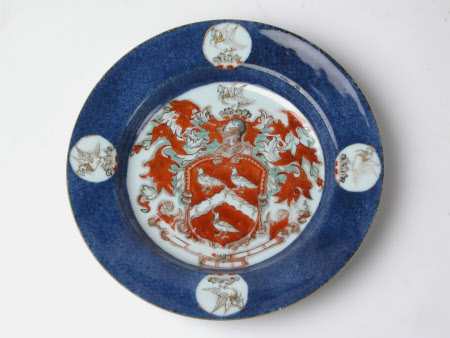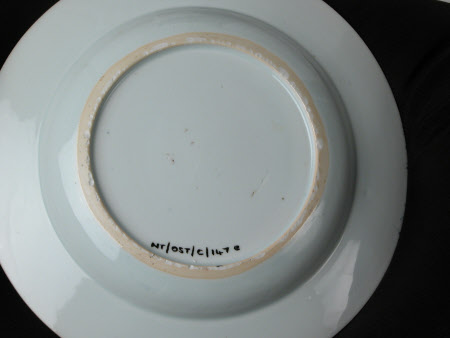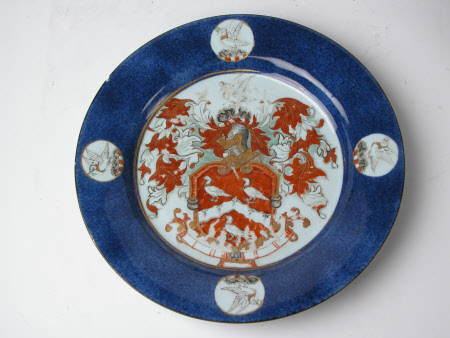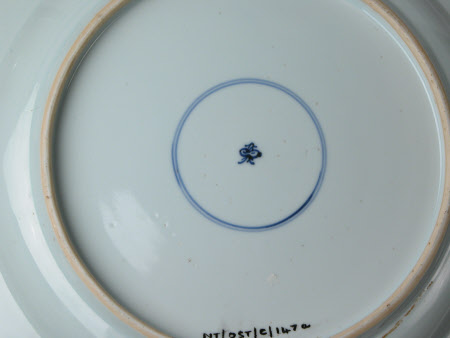Plate
Category
Ceramics
Date
1715 - 1722
Materials
Porcelain, underglaze cobalt blue, polychrome enamels, gilt
Measurements
220 mm (Diameter)
Place of origin
Jingdezhen
Order this imageCollection
Osterley Park and House, London
NT 771442.5
Summary
Plate from a part Chinese armorial table service, porcelain, the centres painted in iron-red, green, sepia and gold, each with a coat of arms of the Child family, Gules, a chevron engrailed ermine between three eagles close argent, each gorged with a ducal coronet or, before a foliate mantling, framed by a powdered underglaze cobalt blue border with four circular reserves enclosing the family crest on a rock proper an eagle rising with wings endorsed argent, gorged with a ducal coronet or, holding in the beak an adder proper; the reverse with a lingzhi (sacred fungus of immortality) within double concentric rings in underglaze blue. Ensuite with 771307 and 771443.
Full description
In the early eighteenth century, the ultimate status symbol for directors of the East India Company and their colleagues, who controlled and profited from English trade with China, was porcelain, lacquer and silk emblazoned with their coat of arms. Between 1715 and 1725, when three of its members served as directors of the company, the Child family of London and Osterley Park, Middlesex, placed orders for armorial porcelain, including this service of plates and graduated dishes, now numbering seventeen pieces. It is decorated with the coat of arms granted in 1700 to the goldsmith, banker and director of the East India Company Sir Francis Child the Elder (1642–1713), Jeweller-in-Ordinary to William III. The original order, accompanied by a painting or bookplate with the coat-of arms to serve as a model, has apparently not survived. It may have resembled a rare surviving order, made around 1728 by the Tower family following the death of the wealthy Deputy Collector of Inwards Customs for the port of London, Christopher Tower of Huntsmoor Park, Buckinghamshire. They sent a copy of their arms painted in colour on vellum inscribed with a request for ‘6 Punch Bowls Coloured to these Arms / On the outside to be Enameld / Ware’, as well as two armorial tea sets and ‘Lacquered Ware Vizt. / 2 Tea Tables / 1 Skreen of 8 leaves and 8 foot high / 1 Dressing Box & Square Table’. [1] The Child arms, painted in a limited palette of iron-red, translucent green, grey and black, known in Europe as famille verte, with gold details, is uniquely framed within an underglaze chuiqing (‘blown blue’) or powdered cobalt blue ground. Chuiqing involved blowing powdered cobalt through a bamboo tube with a filter onto unfired glazed vessels, over masked panels. The scheme on the Child service imitates a group of opulent dishes made in Jingdezhen for export. [2] Child may have owned such costly dishes or seen examples of the technique in the Netherlands in 1697, when he admired the porcelain and lacquer at Huis ten Bosch, a royal residence in The Hague. [3] There are earlier examples of the powdered blue grounds at Osterley, a punch bowl and a pair of large fish bowls. [4] The only known service with this costly powdered blue ground, it was ordered either by Sir Francis Child or his eldest son, Sir Robert (1674–1721), also a director of the East India Company, later head of the eponymous family bank. An acknowledged connoisseur, patron and collector, Sir Robert was a member of St Luke’s Club, an exclusive artistic society, and had begun to modernise the Elizabethan mansion at Osterley shortly before his death. [5] Also at Osterley are gold- and red-painted black lacquer wares with the same heraldic design, some of which may have been ordered by Sir Robert for his house at no. 42 Lincoln’s Inn Fields, which he acquired in 1702. Made in various workshops in Guangzhou (Canton), they now include ten hall chairs, an eight-fold lacquer screen, two coffers, a table, and a domed dressing box of about 1710–25. [6] The assemblage probably represents several orders by the Child family. The porcelain armorial service was later supplemented with matching pieces made of a form of white stoneware known as ironstone, ordered by Sarah Sophia Child Villiers, Countess of Jersey (1785–1867), from the Staffordshire factory of Miles Mason (1752–1822). A former Oriental china retailer, Mason announced in 1804 that he ‘proposed to renew or match the impaired or broken services of the nobility and gentry’. [7] Clearly, the dynastic service was still in use a century later. Literature: William Griggs, Illustrations of Armorial China (London, 1887), no. 2, part 1, no. 2; Tudor-Craig 1925, p. 41; Howard 1974, A8, p. 175; and Du Boulay 1995, pp. 19–20. Notes 1. Howard 2003, pp. 11–2 and 142. 2. NT 870942; and Eikelmann 2009, cat. no. 107. 3. LMA, Jersey Family Papers, acc/1128/177. 4. NT 771309 and NT 771303.1–2. 5. Yuthika Sharma and Pauline Davies, ‘“A Jaghire Without a Crime”: East India Company and the Indian Ocean Material World at Osterley 1700–1800’, The East India Company at Home 1757–1857 (2013), p. 15: blogs.ucl.ac.uk/eicah/files/2013/02/Osterley-Park-pdf-Final-19.08.14.pdf (accessed 30 March 2016). 6. NT 771891; and David S. Howard, A Tale of Three Cities: Canton, Shanghai and Hong Kong (London, 1997), cat. no. 224, pp. 172–3. 7. NT 771307.12–16: Geoffrey A. Godden, Godden’s Guide to Mason’s China and the Ironstone Wares (Woodbridge, Suffolk, 1980), p. 62; and see also examples at Shugborough, Staffordshire, NT 1270513. Text adapted from Patricia F. Ferguson, Ceramics: 400 Years of British Collecting in 100 Masterpieces, Philip Wilson Publishers, 2016.
Provenance
There is no secure evidence identifying which member of the family ordered the armorial service, however, with respect to its date, c. 1715-1722, it was either ordered by Sir Francis Child (1642-1713) or Sir Robert Child (1674–1721), both were involved in the East India Company. Part of the Jersey bequest, March 1993.
Credit line
The Jersey Collection, Osterley Park National Trust Collections
Marks and inscriptions
symbol of a sacred fungus (lingzhi) within concentric circles in underglaze cobalt blue
References
Ferguson 2016: Patricia F. Ferguson, Ceramics: 400 Years of British Collecting in 100 Masterpieces, Philip Wilson Publishers, 2016, 60-1.




